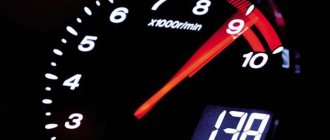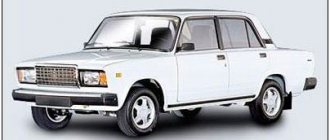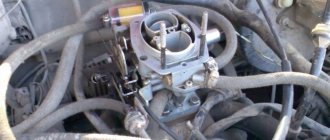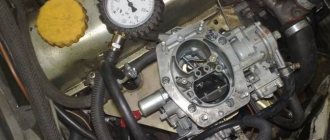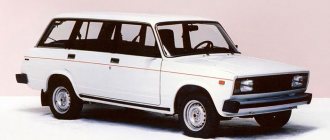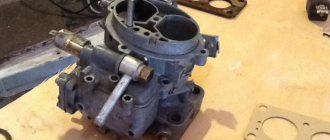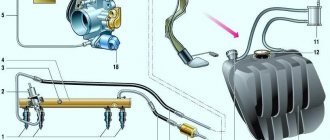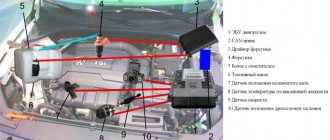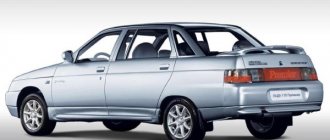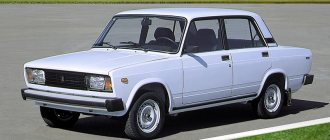The fuel consumption of the VAZ-2107 depends both on the engine displacement and on the method of supplying the fuel mixture. Since the car body has high aerodynamic resistance, and the transmission design with rear-wheel drive additionally loads the power unit, fuel costs on the highway do not fall below 8 liters, and in the city they reach 11-12 liters per 100 km.
fuel consumption of VAZ-2107 on a flat road
Factory fuel consumption standards for VAZ-2107
VAZ-2107 cars used in-line 4-cylinder liquid-cooled engines built on the basis of a unified block. A modification of the VAZ-21079 with a 140-hp Wankel rotary engine was assembled in small batches for the Ministry of Internal Affairs and the KGB of the USSR. With.
Both 4-speed and 5-speed transmissions can be installed (the gear ratio of the main pair depends on the volume and power of the engine).
The efficiency characteristics declared by the plant are shown in the table.
| Motor model and power type | Working volume, cm³ | Power, l. With. | City, l/100 km | Highway (90 km/h), l/100 km | Combined cycle, l/100 km |
| 2101 (carburetor) | 1198 | 64 | 10,0 | 6,3 | 7,5 |
| 21011 (carburetor) | 1294 | 69 | 9,4 | 6,9 | 8,5 |
| 2105 (carburetor) | 1294 | 69 | 9,4 | 6,9 | 8,5 |
| 2103 (carburetor) | 1452 | 72-77 | 10,3 | 7,4 | 10,1 |
| 2106 (carburetor) | 1596 | 75-80 | 9,6 | 7,1 | 8,5 |
| 2103 (injection) | 1452 | 68 | 8,9 | 7,4 | 8,5 |
| 2106 (injection) | 1596 | 73 | 9,7 | 7,3 | 8,5 |
| 21213 (injection) | 1690 | 80 | 8,9 | 7,4 | 8,5 |
Fuel consumption of VAZ-2107 on a carburetor car
The “Seven” used several types of carburetor engines with a volume of 1.2 to 1.6 liters. The fuel consumption of the VAZ-2107 depends both on the type of transmission and on the general technical condition of the car. When the sedan is used in winter in dense city traffic, the engines burn up to 13-14 liters of gasoline for every 100 km of travel; in summer, the parameter decreases by 1-2 liters. On the highway at 90 km/h you can meet 7-7.5 liters, but when the speed increases to 120-130 km/h, consumption increases by 25-30%.
model with 1.2 l engine
The 1.2 liter engine was used to a limited extent in the 80s. last century on cars intended for export to Europe. Cars are occasionally found in Russia, but due to insufficient engine power, owners install units with increased volume. Fuel consumption of a VAZ-2107 with a 1.2 liter engine in city traffic is from 11 liters of A-92 gasoline, but on the highway at 90 km/h it is the most economical: fuel consumption does not exceed 6.5 liters with a working carburetor and ignition.
VAZ engine volume 1.2 l
1.3 l engine
On the VAZ-2107 there are 1.3-liter engines 21011 and 2105, equipped with a chain and belt drive of the gas distribution mechanism, respectively. According to owners' reviews, gasoline costs in the city do not fall below 10 liters per 100 km; on the highway at 90 km/h, engines burn from 7 to 8 liters of fuel.
... about fuel consumption
Since the cars were equipped with 4-speed gearboxes, further acceleration leads to a rapid increase in fuel consumption (for example, at 110 km/h the parameter reaches 9 liters per 100 km).
1.5 l engine
The 2103 carburetor engine could be equipped with a manual transmission with 4 or 5 steps. Regardless of the type of transmission, consumption in the city is in the range of 10.5-11 liters, in heavy traffic the parameter reaches 12 liters. On the highway at a speed of 90 km/h, cars with a 4-speed gearbox require about 8 liters of gasoline; when using a 5-speed unit, fuel costs drop by 0.5-0.7 liters.
Carburetor engine 2103
1.6 l engine
Engines with a volume of 1.6 liters began to be used on the VAZ-2107 from 1982 along with a 4-speed gearbox, which was later replaced by a 5-speed transmission. Consumption in urban conditions in summer is 11-12 liters; in winter, engines burn up to 14 liters of gasoline. On the highway, at a calm pace of movement, the car fits into the standard 7 liters, but when operating with a full load or a trailer, fuel costs reach 8.5-9 liters per 100 km.
Aerodynamics of the car
Many Russian drivers have already noticed that the fifth model has much lower consumption due to its aerodynamic properties. We are talking about a radiator grille that is flush with the hood, and does not stick out, as on the seven. The high “nose” of the grille creates additional air resistance, which leads to excessive fuel consumption. In this case, it is recommended to install the hood and grille from the VAZ 2105.
The second reason is a roof rack that has too much protruding cargo. Tall suitcases, boxes and other items carried on the roof also make it difficult for the vehicle to move, causing the engine to consume much more gas than it should. The best way out of the problem is a trailer that hides behind the car, is lightweight and can hold more cargo than a trunk.
Open windows when driving on the highway also interfere with normal gasoline consumption. If the car is hot, you can use central air ducts, which open at speed and set the flow of cold air, which is much more convenient and economical.
Fuel consumption VAZ 2107 injector
Engines with distributed fuel injection consume 5-7% less fuel and comply with environmental standards up to Euro-3 by adjusting the mixture composition with an electronic controller. The injection system has a simplified design (for example, there is no knock sensor). Depending on the year of manufacture of the machine, elements of both imported and domestic production are used.
... about injection versions
Injectors began to be installed in the early 90s. for cars exported, and by 2006 the production of carburetor versions was completed.
Engine 1.5 l
The VAZ-2107 has a 1.5-liter engine with a fuel injection system that meets Euro-2 standards. The cars were produced in small batches, and then a modification with a 1.6-liter injection unit began to be mass-produced.
With a working fuel supply system, consumption in city traffic is 11 liters; during sudden acceleration or in winter, the parameter increases by 1-2 liters. On a suburban highway, a car burns about 8 liters of gasoline (with the interior partially loaded and speeds up to 100 km/h).
Lada VAZ-2107 injector
Gasoline consumption on the seven 1.6 l
1.6-liter engines with distributed gasoline injection began to be installed on VAZ-2107 cars from the early 2000s. Average consumption in urban conditions is 10-10.5 liters (the plant recommends using gasoline with an octane rating of 95 units), on the highway the engine requires from 7 to 8.5 liters of fuel (at speeds of 90 and 120 km/h, respectively). In the combined cycle, the fuel consumption of the VAZ-2107 is 8.5 liters of fuel per 100 km (the range with a fully filled 39-liter tank does not exceed 450-470 km).
1.7 l engine
An engine with increased power and single-point injection from GM began to be installed on export modifications of the VAZ-2107 in the early 90s. Some of them ended up on the Russian domestic market. In the city, a car requires 10 liters of fuel (consumption depends on air temperature and flow density); on a suburban highway, with the cabin partially loaded and at a speed of up to 100 km/h, it can reach 7.5 liters.
... about fuel consumption
Owners of cars with a mileage of more than 150 thousand km are faced with an increase in fuel costs by 30-40%, associated with wear of the piston group and breakdowns of the throttle unit and injector.
Driving in neutral gear Engine 15 with injector
| Fuel consumption standards for VAZ 21074 injector It should be noted that this driving style is dangerous if the engine stalls, the vacuum brake booster stops working, braking efficiency noticeably decreases, which leads to an emergency. All advice can be divided into two groups: real, which bring practical benefits, and dubious, which only benefit sellers of sophisticated devices for reducing fuel consumption. |
| Consumption of a VAZ 2107 carburetor in winter Sometimes motorists give advice on how to save the most money on the Republic of Tatarstan, but not all the proposed methods work, and often savings using such methods turn out to be incomprehensible. It must be emphasized that idling is far from the most economical mode; if you measure the CO level with a gas analyzer, then at idle the device will show the emission of harmful impurities in the exhaust gases no less than at medium speeds. |
- hydraulic chain tensioner;
- hydraulic valve compensators.
Aggressive driving style • All drivers should know that without oxygen, fuel combustion is impossible.
The main factors influencing the fuel consumption of the VAZ-2107
The following factors influence fuel consumption:
- driving mode and control features;
- Incorrectly set or faulty ignition - early or late ignition leads to untimely ignition of the fuel mixture
- Rough idling can be one of the causes of misfires and, in turn, increase fuel consumption;
- worn high-voltage ignition wires (especially on cars with high mileage);
- incorrect operation of the carburetor;
- malfunction of the ignition coil, especially with a contact ignition system, regularly causes problems with the disappearance of the spark in the cylinders, which accordingly increases fuel consumption;
- breakdown of the catalytic converter or failure of oxygen concentration sensors (on versions with distributed injection);
- erroneous determination of the optimal speed;
- air filter contamination and untimely replacement of the fuel filter;
- operating a car in winter.
Driving style
During sharp acceleration and driving in low gears at high crankshaft speeds, fuel consumption reaches 14-15 liters in urban conditions. When operating on the highway, it is necessary to maintain the speed within 90-100 km/h (optimal mode, independent of the number of gears and engine displacement). Driving on country roads at a speed of more than 120 km/h leads to an increase in gasoline costs to 9-10 liters per 100 km.
VAZ-2107
The tightness of the needle valve is broken
The needle valve is located in the carburetor's float chamber and maintains the gasoline level (along with a float that closes the valve when the required amount of fuel is reached). Overfilling fuel leads to the supply of additional fuel to the carburetor chambers and deterioration of engine efficiency. Gasoline consumption also increases if the float is adjusted incorrectly.
Incorrect speedometer readings
The VAZ-2107 uses a mechanically driven speedometer, which has reduced measurement accuracy. Due to incorrect determination of speed, the driver may operate the gas pedal incorrectly, which negatively affects efficiency. The vehicle's instrument cluster is equipped with an econometer that determines the optimal engine operating mode based on inlet pressure. To reduce fuel consumption, it is necessary to keep the needle in the green zone, which corresponds to costs in the range of 6-8 liters per 100 km.
Fuel jet malfunction
To supply fuel to the carburetor mixing chamber, jets are used that are screwed into the unit body. If the tightening is incorrect or the thread or internal channel of the nozzle is damaged, gasoline consumption increases and the conditions for the formation of the working mixture are violated. An additional reason for carburetor malfunctions is clogging of the jet channels.
Malfunction of the fuel nozzle VAZ-2107
General factors
The main reason affecting fuel consumption is a decrease in air temperature in winter, which increases the engine operating time on a rich mixture. Slippery road surfaces worsen acceleration conditions. Efficiency depends on the condition of the air filter: when the element is clogged, the intake resistance increases and engine power decreases. Winter affects fuel costs: types of engine and transmission oils are selected depending on the climatic zone of operation.
Reasons for overspending
To determine the causes, technicians use a special device - a tester. They check the electronic control unit and sensors. There are several main reasons when fuel consumption may increase:
- Aggressive driving.
- Precipitation on the walls of nozzles, measurement of their flow area.
- Incorrect operation of the sensors.
- The glow number of the spark plugs does not correspond to that stated by the manufacturer.
- The car's air engine is clogged.
Basic methods for optimizing and adjusting fuel consumption
To reduce fuel costs during year-round vehicle operation, you must:
adjust your driving style, eliminating sudden acceleration and movement at speeds of more than 100 km/h;- do not install elements that increase drag (for example, overlays on door windows or oversized mudguards);
- periodically check the ignition system settings and adjust the carburetor;
- replace spark plugs in accordance with the manufacturer's requirements;
- when the Check Engine light turns on (available only on vehicles with a distributed injection system), diagnose the system;
- on cars with a standard ignition system, it is possible to increase the stability of the ignition system and, accordingly, avoid periodic increases in fuel consumption by installing a contactless ignition system;
- refuel the car with gasoline with an octane rating of at least 92 units;
- carry out timely maintenance and replace the air filter;
- check the functionality of the cooling system thermostat;
- carry out maintenance of hubs and brake mechanisms with replacement of damaged parts;
- Before leaving, check the tire pressure (flat tires negatively affect efficiency);
- do not use mineral oil with a high pour point in the engine, gearbox and rear axle;
- When operating in winter, warm up the engine for 1-2 minutes before driving.
Flushing the throttle valve - Piston group
| 18 tips on how to reduce fuel consumption on a VAZ 2107 The fuel consumption of the VAZ 2107 is quite moderate, and according to this parameter the car can be considered for purchase, however, many reasons depend on how quickly the gasoline leaves the tank, including driving style. You also benefit from fuel if you drive carefully without sudden acceleration, at low speeds, with an engine speed of less than 3000, not exceeding 60-70 km/h. |
| How to reduce fuel consumption on a VAZ 2107? Rationale: Monitor the spark plug gap in a timely manner, which should be about 1 mm, and also change the spark plugs after a certain mileage of the car. Specific calculations are made by the on-board computer based on algorithms that take into account not only the difference in the resistance of the threads, but also the current temperature of the control conductor. |
- gradual reduction of the combustion chamber;
- reduced engine compression, which occurs due to severe wear of the cylinders, valves, rings and piston group, very often happens on the VAZ-2107, since over time these processes are inevitable, especially with such a middle-aged model;
- constant driving on a cold engine - may occur due to the absence or malfunction of the thermostat;
- the car is not rolling and the wheel bearings are tightened;
- spark plug failure;
- high voltage wire is broken;
- low tire pressure, which seriously increases the resistance of traffic on the road;
- the presence of a roof rack or trailer that is heavily loaded;
- impaired valve adjustment;
- delayed ignition and others.
Questionable ways to adjust fuel consumption
Questionable methods for reducing gasoline consumption on both carburetor and injection engines include installing fuel activators on hoses or adding additives to the tank. Magnetic treatment of the hydrocarbon flow does not affect the processes of formation of the working mixture and combustion, so the installation of activators does not bring results. The owner may note a change in consumption of 0.1-0.3 liters, which is a statistical error and is associated with unstable quality of gasoline or a change in the road situation.
Adjusting the carburetor to excessively lean the working mixture and reducing idle speed leads to unstable operation of the engine, which stalls when the speed is reduced. Some owners, when driving downhill, move the gearbox lever to the neutral position. If the engine stops, the brake booster stops working. On a long descent, you must leave the gear engaged and release the accelerator pedal (switch to engine braking mode). Cutting off the fuel supply improves efficiency.
The use of additives negatively affects engine parts on which carbon deposits form, causing glow ignition and disrupting the normal operation of the engine. Until the beginning of the 90s. last century, due to a shortage of AI-93 gasoline, it was practiced to convert engines to fuel with a lower octane number (for example, A-76 was widely used to refuel trucks). The modification consisted of installing a thicker head gasket and adjusting the ignition timing, but it negatively affected the power and service life of the VAZ-2107 engine.
Float chamber needle valve leaking
To avoid this problem, you need to monitor the fluid level and periodically check the condition and tension of the drive belt on the pump. The fuel consumption of the VAZ 2107 is quite moderate, and according to this parameter the car can be considered for purchase, however, many reasons depend on how quickly the gasoline leaves the tank, including driving style.

